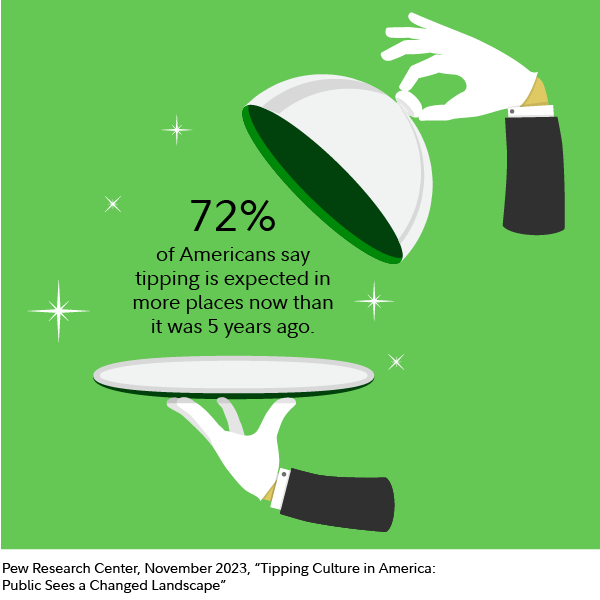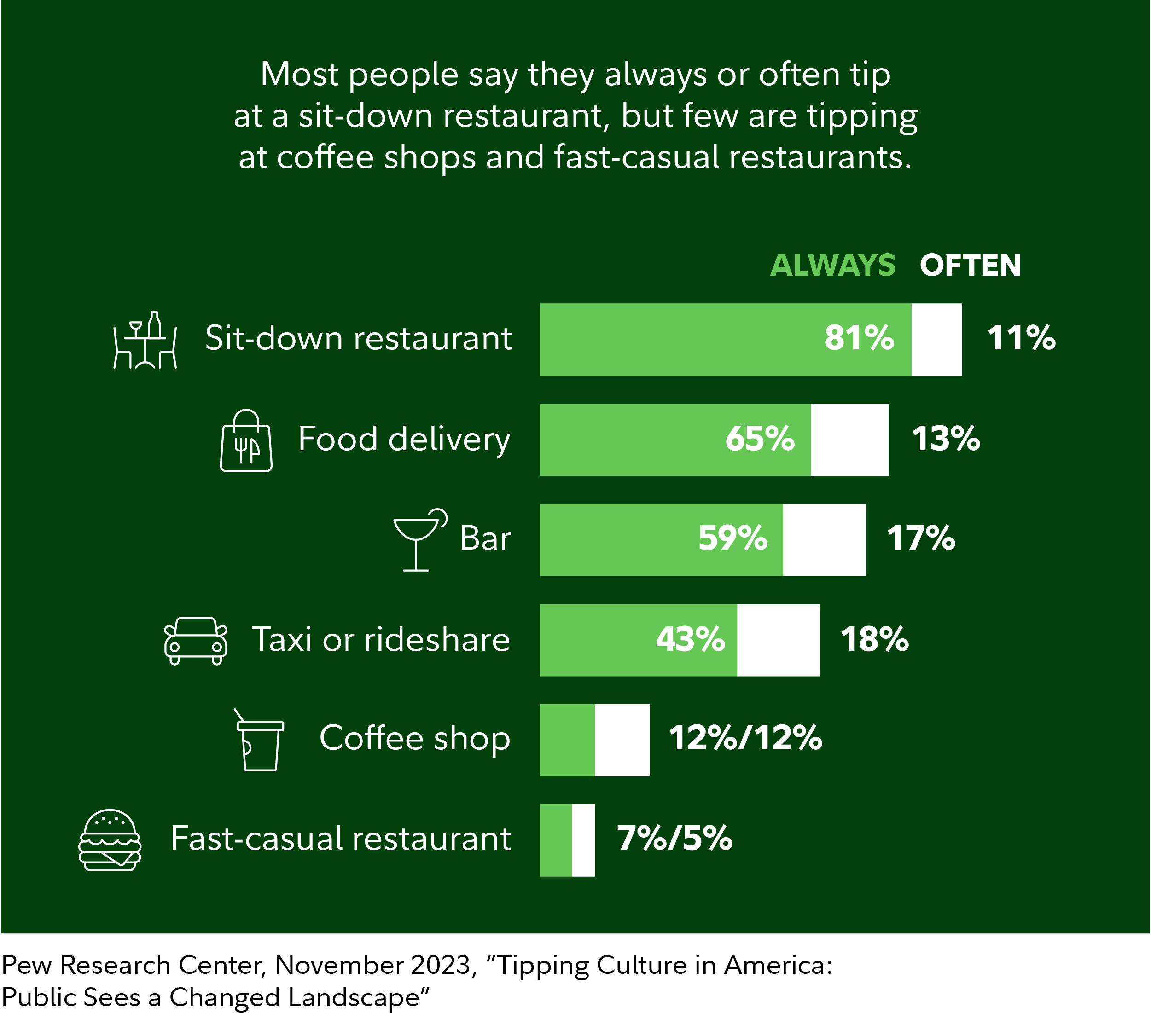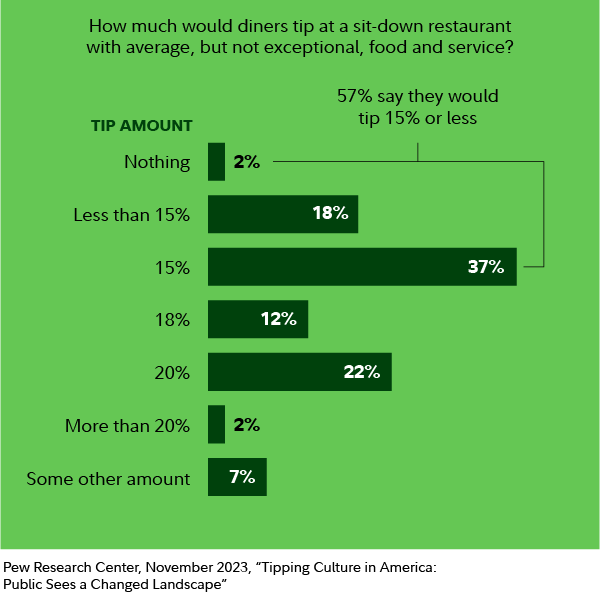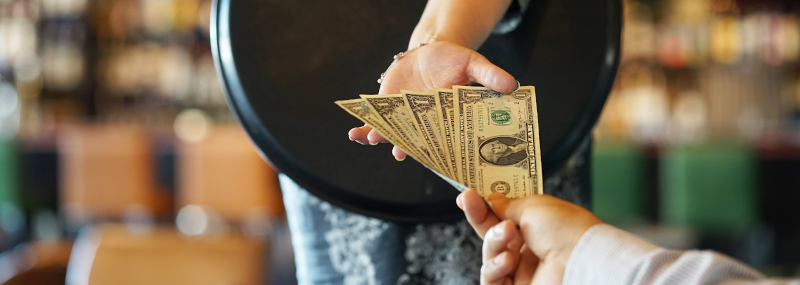Holiday gatherings, year-end errands, and a flurry of digital tip screens—December can feel like peak tipping season. Tipping prompts keep popping up—even as consumers feel tapped out. Nearly 9 in 10 people say tipping culture feels “out of control” in 2025.1 If you’re feeling the squeeze, you’re not alone.
With the holidays approaching, tipping pressure can feel intense. For practical tips, read Smart MoneySM on Fidelity.com: The no-stress guide to holiday tipping
One big driver of “tipflation”? Technology. Digital payment systems with preset tip options have made gratuity requests nearly unavoidable—a trend that took off during the pandemic and shows no signs of slowing.
While it’s wonderful to show appreciation for good service, the act of tipping now comes with a whole new level of awkwardness. Is it OK to hit “no tip” on a tablet after your local barista hands you that latte? Is it callous not to drop a dollar into that “college fund” tip jar?
It depends.

“There are occasions when it’s appropriate—and even customary—to tip,” says Ann Dowd, CFP®, a vice president at Fidelity Investments. “And there are times when tipping is completely discretionary. In a world where tipping requests are prevalent, it’s easy to spend more than you planned on gratuities, so it’s important to be prepared.”
The solution, she says, is to know your budget, familiarize yourself with tipping norms, and have a plan of action. “With some knowledge, prep work, and introspection, you can stay financially on track while showing appreciation for the service professionals who help improve our lives,” says Dowd.
Here’s some gratuity guidance:
1. Get a general grasp of etiquette: Tipping can be a sore spot when traveling. Though tipping scenarios throughout the US tend to be very similar whether you’re in Atlanta or Akron, the rest of the world has very different norms and expectations. For instance, in Japan2 offering a gratuity in a restaurant or bar could be seen as socially inappropriate. On the other hand, tips are expected in some places in Germany but not necessarily in the lavish amounts Americans are accustomed to giving. For instance, a 5% or 10% tip in a restaurant would be customary, a 15% gratuity could be seen as generous.3 Fortunately, it’s easy to research tipping norms generally before you reach your destination with a quick internet search. Once you’re there, you may be able to get more specific guidance from the people around you by asking.
In most cases, tipping comes down to your values and the specifics of your situation. Yet, by understanding general tipping norms, you’ll be less likely to feel awkward or unsure about what to do. Many etiquette books, articles, and websites offer advice on the general expectations around tipping but they may not have caught up to the myriad tipping opportunities that have proliferated in recent years.
There is flexibility in what to give, yet it’s important to remember that certain service workers in the US, such as waitstaff and bartenders, often depend on tips to make a living. If you want to skip the tip after receiving poor restaurant service, talk to the manager to explain why you feel compelled to do so, says Jodi R.R. Smith, founder of Mannersmith Etiquette Consulting. “Management cannot fix something if they do not know there is a problem,” she says, adding that the problem could be with communication between servers, timing within the kitchen, or poor staff training.
2. Give extra for extra effort: If your coffee order sounds something like this: “2 and a half pumps of vanilla, half soy and half almond milk, a dusting of cinnamon, and extra hot,” tip more generously than you would normally. Giving a little more money is courteous anytime someone goes above and beyond. For instance, while it’s customary to tip between 10% and 15% of a food delivery bill, boost that up if the total is modest, say $10, or if the driver braves harsh weather to drop off your pepperoni pizza.

3. Create a standard operating procedure: Jot down the tipping situations you might face and how you’d like to respond. This isn’t to suggest ways of tipping less than you might otherwise but simply to have a plan of action before a tip is requested. For example, you can decide that, in general, you won’t tip at self-service convenience stores, will put the change from your morning muffin into the tip jar, give a minimum of 18% at restaurants, and generally not go over 15% at other places unless service is exceptional. By following some guidelines, you’ll be less apt to tap the 25% button hastily.
And if you do panic and hit a high percentage, give yourself some grace.
“This is new territory for many of us, and we’re all learning how to navigate it,” says Dowd. “Make a mental or physical note of what happened. Then, the next time you’re unexpectedly asked to tip, take a moment before you decide. Think back to what makes you most comfortable.”
If you decide after the fact that you under-tipped, in many cases you can go back and give more.
4. Carry cash for more control: Even for the math-minded, it can be tough to figure out percentages while juggling a just-bought sandwich, chips, and soft drink. Tipping in cash allows you to stick with your standards more easily. For instance, if you regularly buy lunch from a local deli, you can decide to always tip a dollar or two. By tipping in cash—and not responding to an immediate credit card prompt—you can step aside after your purchase and give more mindfully.

5. Factor tips into your spending plan. If you’re going to a sit-down restaurant or another establishment where tipping is customary, it’s crucial to factor tips into your budget, says Smith. Many restaurants have increased their prices to keep up with inflation, so if you’re unsure what the cost will be, check an online menu before you go.
Even if you’re tempted by the cabernet or crème brûlée once you’re at dinner, don’t subtract from the tip to cover those costs.
“If I only have $50 to go out, I may not get a glass of wine, or I’ll decide between an appetizer or a dessert,” says Smith. If you’re the type of person who enjoys a multi-course meal with wine pairings, hold off on making that reservation until you can cover the full cost.
6. Express gratitude with non-monetary gestures. There are many ways to show appreciation without spending any money.
“If someone is doing a great job, let headquarters know,” Smith says. “You can write an email or fill out a form on their website and say, ‘I was at your store on Sunday, and Taylor the barista made a coffee that was simply perfection.’"
In addition, you can also give the person or place a positive online review or a shout-out on social media.
And whether you decide to tip or not, it’s always polite to say a sincere thank you and express your appreciation for service given by others.


